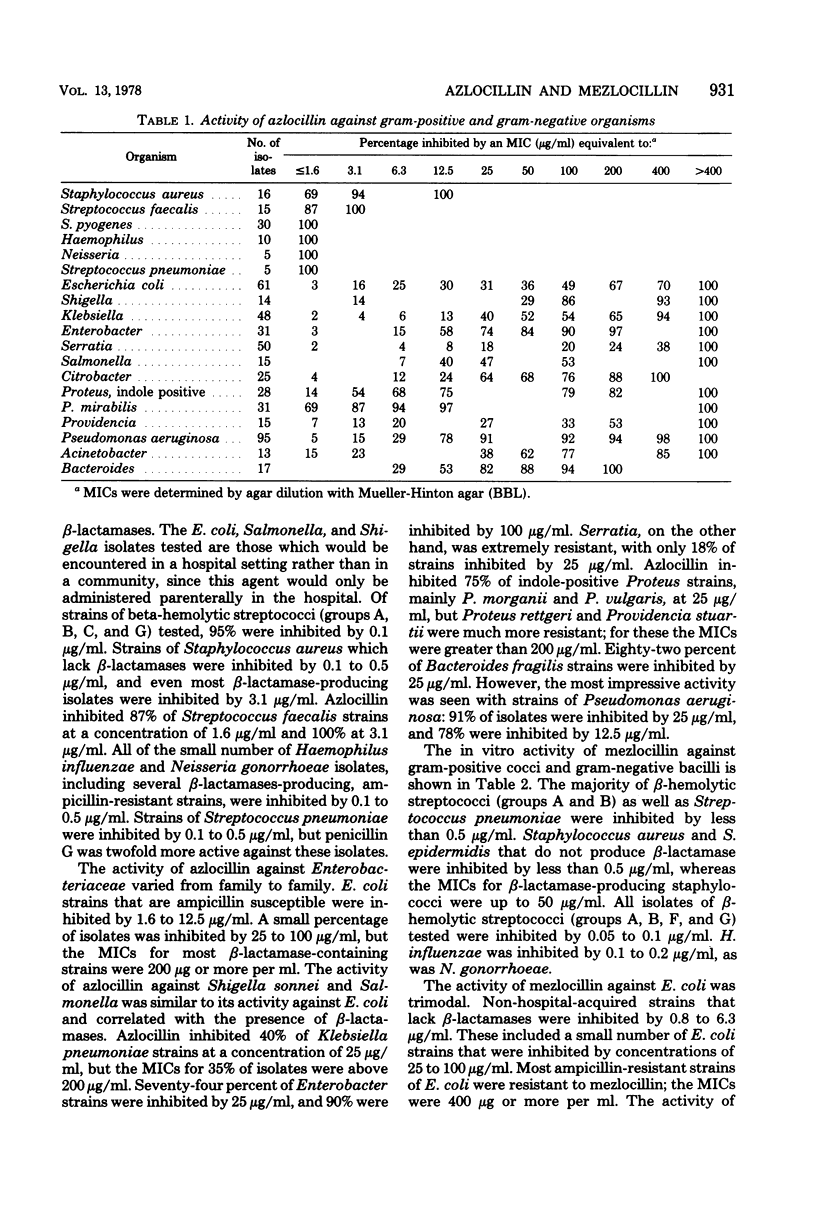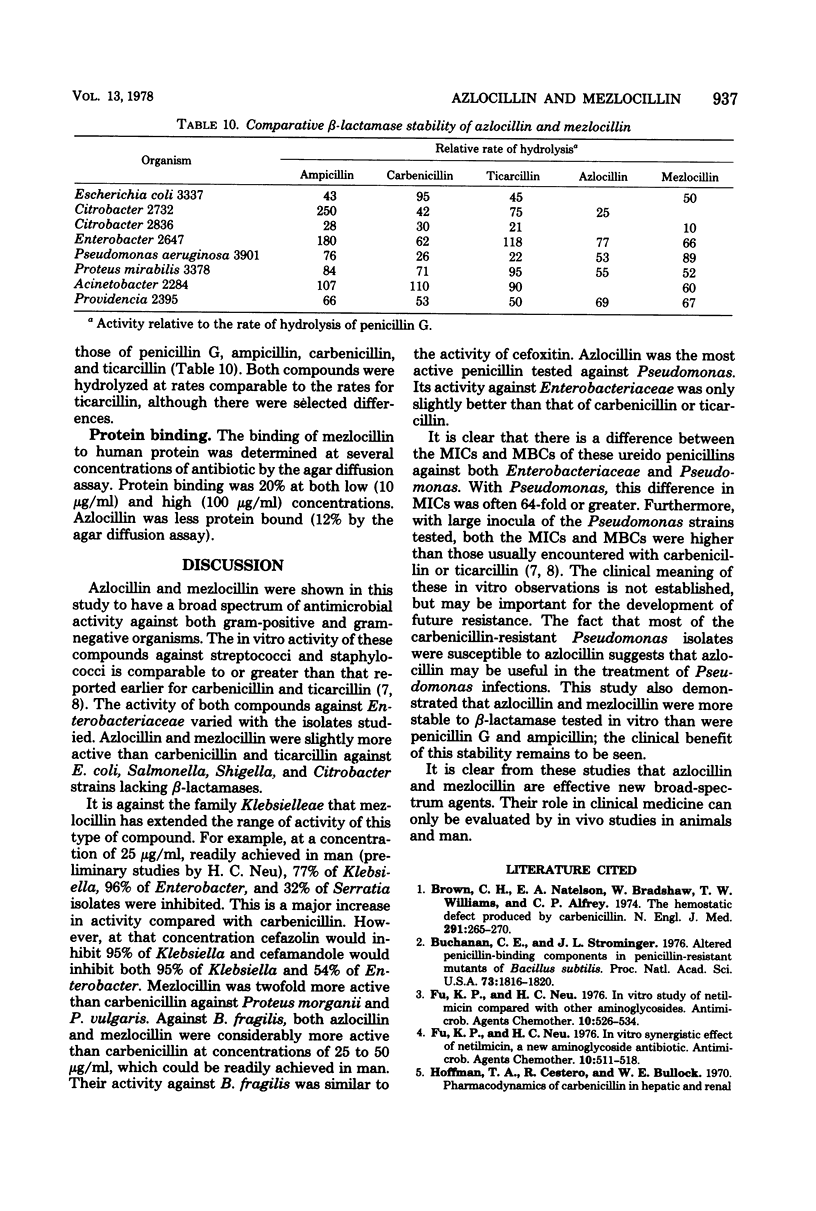Abstract
The activity of azlocillin and mezlocillin, new semisynthetic ureido penicillins, was investigated and compared with that of other known β-lactam antibiotics. At a concentration of 25 μg/ml, azlocillin inhibited 74% of Enterobacter, 97% of Proteus mirabilis, 64% of Citrobacter, 91% of Pseudomonas aeruginosa, and 82% of Bacteroides strains tested. Mezlocillin inhibited 86% of Shigella, 96% of Enterobacter, 80% of indole-positive Proteus, 88% of Bacteroides, and 63% of Pseudomonas strains tested. Azlocillin was more active against Pseudomonas than was ticarcillin, carbenicillin, or mezlocillin. Mezlocillin was more active than carbenicillin and ampicillin against Escherichia coli, Klebsiella, Enterobacter, Citrobacter, Acinetobacter, Serratia, and Bacteroides. Azlocillin and mezlocillin were less active than cefazolin against β-lactamase-producing E. coli and Klebsiella strains but more active than cefazolin against Enterobacter, indole-positive Proteus, Acinetobacter, Citrobacter, and Serratia strains. Both compounds showed activity equivalent to that of cefoxitin against Bacteroides isolates. Both agents were destroyed by many of the β-lactamases from gram-negative organisms.
Full text
PDF








Selected References
These references are in PubMed. This may not be the complete list of references from this article.
- Brown C. H., 3rd, Natelson E. A., Bradshaw W., Williams T. W., Jr, Alfrey C. P., Jr The hemostatic defect produced by carbenicillin. N Engl J Med. 1974 Aug 8;291(6):265–270. doi: 10.1056/NEJM197408082910601. [DOI] [PubMed] [Google Scholar]
- Buchanan C. E., Strominger J. L. Altered penicillin-binding components in penicillin-resistant mutants of Bacillus subtilis. Proc Natl Acad Sci U S A. 1976 Jun;73(6):1816–1820. doi: 10.1073/pnas.73.6.1816. [DOI] [PMC free article] [PubMed] [Google Scholar]
- Fu K. P., Neu H. C. In vitro study of netilmicin compared with other aminoglycosides. Antimicrob Agents Chemother. 1976 Sep;10(3):526–534. doi: 10.1128/aac.10.3.526. [DOI] [PMC free article] [PubMed] [Google Scholar]
- Fu K. P., Neu H. C. In vitro synergistic effect of netilmicin, a new aminoglycoside antibiotic. Antimicrob Agents Chemother. 1976 Sep;10(3):511–518. doi: 10.1128/aac.10.3.511. [DOI] [PMC free article] [PubMed] [Google Scholar]
- Klastersky J., Vanderklen B., Daneau D., Mathiew M. Carbenicillin and hypokalemia. Ann Intern Med. 1973 May;78(5):774–775. doi: 10.7326/0003-4819-78-5-774. [DOI] [PubMed] [Google Scholar]
- Neu H. C., Garvey G. J. Comparative in vitro activity and clinical pharmacology of ticarcillin and carbenicillin. Antimicrob Agents Chemother. 1975 Oct;8(4):457–462. doi: 10.1128/aac.8.4.457. [DOI] [PMC free article] [PubMed] [Google Scholar]
- Neu H. C., Winshell E. B. Purification and characterization of penicillinases from Salmonella typhimurium and Escherichia coli. Arch Biochem Biophys. 1970 Aug;139(2):278–290. doi: 10.1016/0003-9861(70)90479-0. [DOI] [PubMed] [Google Scholar]
- Sykes R. B., Nordström K. Microiodometric determination of beta-lactamase activity. Antimicrob Agents Chemother. 1972 Feb;1(2):94–99. doi: 10.1128/aac.1.2.94. [DOI] [PMC free article] [PubMed] [Google Scholar]


